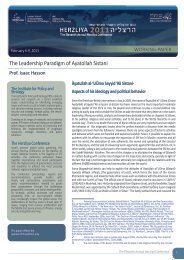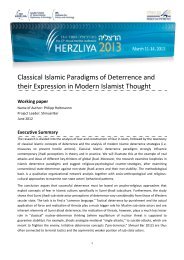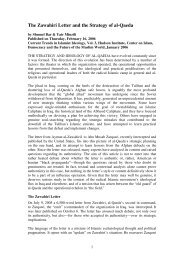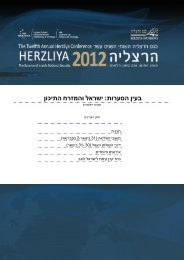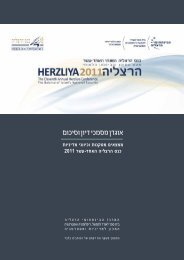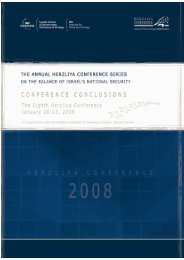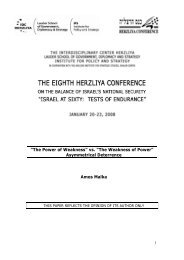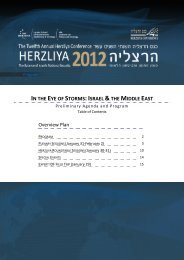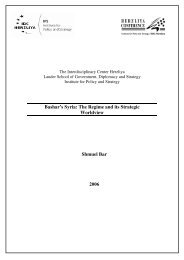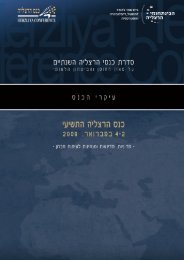Iran: Cultural Values, Self images and Negotiation Behavior
Iran: Cultural Values, Self images and Negotiation Behavior
Iran: Cultural Values, Self images and Negotiation Behavior
Create successful ePaper yourself
Turn your PDF publications into a flip-book with our unique Google optimized e-Paper software.
<strong>Iran</strong>: <strong>Cultural</strong> <strong>Values</strong>, <strong>Self</strong>-<strong>images</strong> <strong>and</strong> Negotiating <strong>Behavior</strong>admiration of dervishism. This is not seen as contradictory to <strong>Iran</strong>ian character butrooted in the true character of the nation. 75The second offshoot of the javanmardi ethos is luti-gari. 76 The lutis were the<strong>Iran</strong>ian Robin Hood; <strong>and</strong> belonged to distinct orders (not unlike those of the Sufi) thatdeveloped in the nineteenth century. They wore emblems of membership, behaved ina distinct fashion, <strong>and</strong> were expected to be true to the principles of javanmardi <strong>and</strong> tostrive for excellence in areas of physical training <strong>and</strong> sports in the <strong>Iran</strong>ian gymnasium(zur-khanah). The luti did not seek leadership or ask for rewards for their good deeds.Since they were known as both honest <strong>and</strong> physically fit, they frequently became thecommunity civil guard, patrolling the streets <strong>and</strong> extending support to the needy. 77Today the luti-type is the neighborhood tough-guy who becomes a local champion<strong>and</strong> enforces a sort of local justice. His responsibility derives from his physicalprowess. Like the dervish, the luti-type is a popular hero in modern <strong>Iran</strong>ian cinema. 78Religiosity <strong>and</strong> SuperstitionDespite a pervasive <strong>and</strong> deep mistrust of the clerical establishment (see below – theMullah), <strong>Iran</strong>ian society is highly religious. The Reformists are not secular, <strong>and</strong> mostof them do not call for a total separation of religion <strong>and</strong> State. Even the Shah – despitethe present regime’s propag<strong>and</strong>a – was a believing Shiite Muslim. His aversion to the‘Ulama did not detract from this fact, as it does not prevent many other <strong>Iran</strong>ians fromexpressing mistrust towards the mullahs <strong>and</strong> a deep belief in the Prophet <strong>and</strong> theImam ‘Ali.Alongside official orthodox Shiite Islam, popular heterodox beliefs <strong>and</strong>superstitions enjoy wide currency in <strong>Iran</strong>. Many of the customs <strong>and</strong> beliefs unique to<strong>Iran</strong>ian Shiite Islam have their origins in ancient <strong>Iran</strong>ian Zoroastrianism. This isespecially true about the <strong>Iran</strong>ian concept of leadership. Popular <strong>Iran</strong>ian Shiite Islaminherited from Zoroastrianism the belief in reincarnation. Thus, much as King Dariusproclaimed himself the reincarnation of the mythical hero Fereyidoun (who saved <strong>Iran</strong>from the tyrant Zahaak <strong>and</strong> the devil Ahriman), Khomeini’s claim that he guides <strong>Iran</strong>on behalf of the hidden Imam was popularly interpreted as his being the reincarnationof the hidden Imam.Another ancient <strong>Iran</strong>ian belief is that all events on earth are a reflection of celestialevents. Astrology <strong>and</strong> other esoteric forms of foretelling <strong>and</strong> explaining events arewidely accepted in <strong>Iran</strong>. Some expressions of political manipulation of this factorwere the rumor spread after the Revolution that the face of Ayatollah Khomeiniwould appear on the full moon – traditional proof of his having been anointed asleader. As a result, <strong>Iran</strong> was witness to a mass sighting of Khomeini’s face. 79 Anotherinstance was the story spread that anyone who opens the Koran to the sura of al-75 See Bateson 264–270.76 It is of interest that the word Luti is borrowed from Arabic, where it connotes a passive homosexualman; in Persian it came to mean a machoistic character.77 Arasteh 26–29.78 Bateson267.79 Fereydoun Hoveyda, The Shah <strong>and</strong> the Ayatollah – <strong>Iran</strong>ian Mythology <strong>and</strong> Islamic Revolution.(London: Praeger, 2003) 35. In interviews, a number of <strong>Iran</strong>ians, including anti-Regime exiles haverepeated the story of this “sighting.”18



